Some cat breeds have the most beautiful and eye-catching colors, and the Siamese is the perfect example of this. Besides coming in a range of stunning colors, the Siamese breed has a distinct personality that has won them a legion of loyal fans.
Siamese cats can be intelligent, noisy, and sometimes demanding, but for those of us who love them, this is all part of their charm. Their striking coloration is also something that Siamese cat owners love. You’ve probably seen a Siamese cat with the classic seal points, but did you know that there’s a huge number of other possibilities? We’ll explore these colors in this article.
How Do Siamese Cats Get Their Color?
Siamese cats have a distinct type of markings due to something called the “Himalayan gene.” The pointed markings seen on Siamese cats are actually a type of albinism due to an enzyme that produces melanin, or color, in the cat’s fur. This enzyme doesn’t function at body temperature, so most of a Siamese cat’s fur will stay white or cream, with no melanin produced.
At their extremities, however, it’s a different story. Here, because the temperature is cooler, melanin will be produced, leading to darker colored fur. So, the paws, tail, ear tips, and face of your Siamese cat will show their “true” color.
Siamese cats living in warmer climates will often have lighter-colored coats and points than those in colder locations. How cool is that!
All Siamese kittens are born a white or cream color. It’s only when they get to be around 1 month of age that their points will start to appear. At that time, it’s possible to define their adult color, and there are many possibilities.
Now, let’s take a look at all these gorgeous shades of Siamese cats!
Standard Siamese Cat Colors
First off, there are four main colors accepted in the official Breed Standard for the Siamese in the U.S.A.
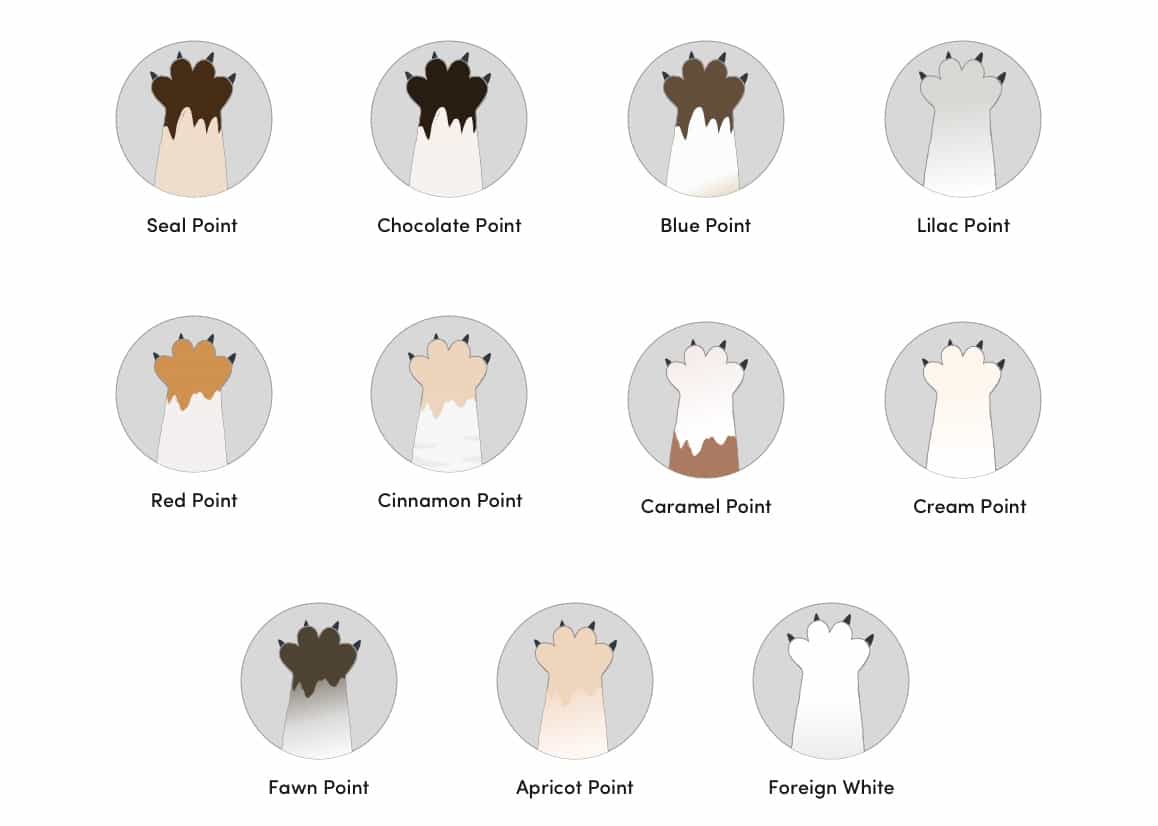
1. Seal Point
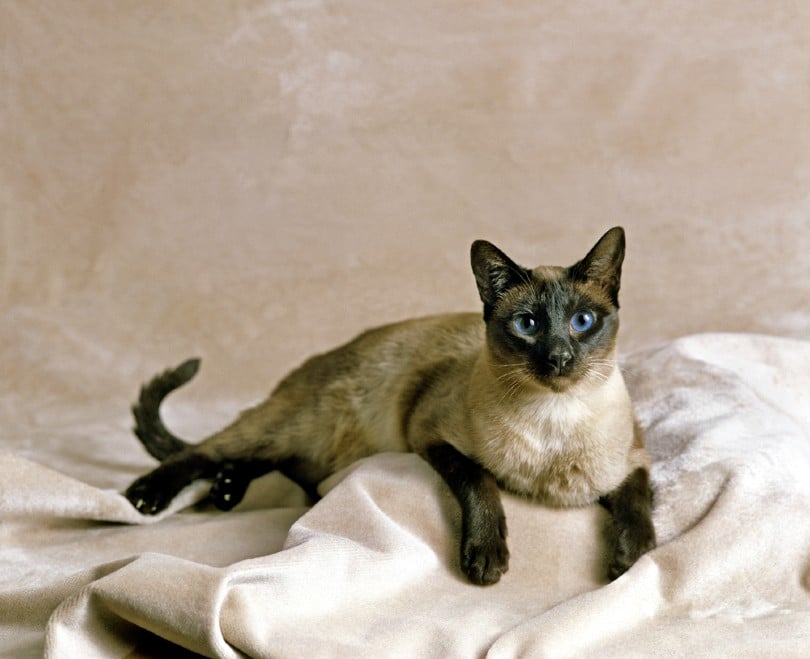
This is the classic Siamese color that most of us are familiar with. At one point, this was the only accepted color for Siamese cats. The seal points are a rich and dark chocolate color, bordering on black. Their nose leather and paw pads will also be a deep brown.
2. Chocolate Point
Chocolate-pointed Siamese cats have points the color of pale milk chocolate, which contrasts with the rest of their white fur. Their noses and paw pads are often pale browns with a hint of pink. Chocolate is technically a dilution of the darker seal point.
3. Blue Point
Blue point Siamese cats have shading in a beautiful, cool, silvery gray. Their color may darken as they get older. Siamese cats with blue points will have dark grey-colored noses and paw pads. This is another variation of a diluted shade of the original seal coloration.
4. Lilac Point
The lilac point is a warm gray color with a hint of pink running through it. You might sometimes see this color also referred to as frost point. The lilac points may be less well defined than the previous three colors, but they do contrast with the pale white coat. The paw pads and nose of a lilac-pointed Siamese will be a soft pink. The lilac point is a diluted version of the chocolate point.
More Siamese Cat Colors
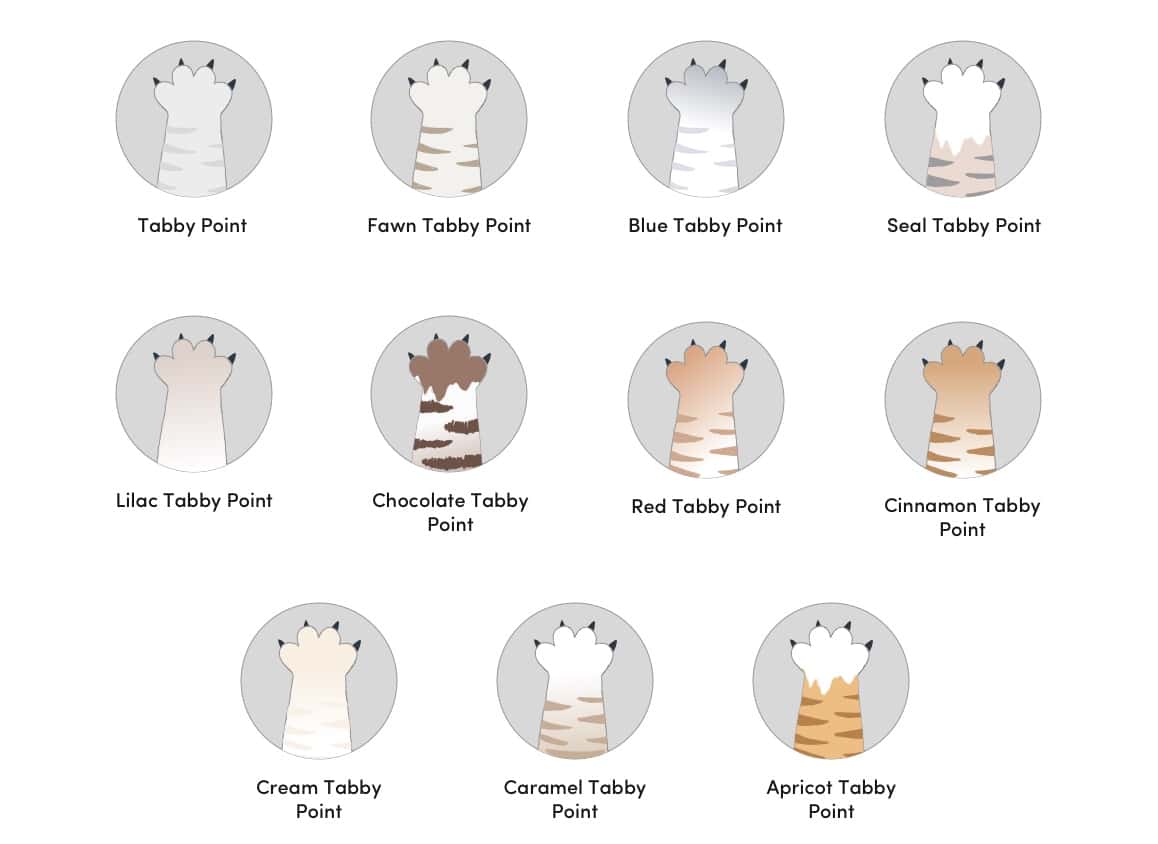
In addition to the four classic colors we’ve covered above, there is now a huge variety of other colors you might see concerning Siamese cats. Most of these aren’t accepted by the breed standards used in different countries, as they require crossing with different breeds to achieve the various colors and patterns of the points.
5. Red Point
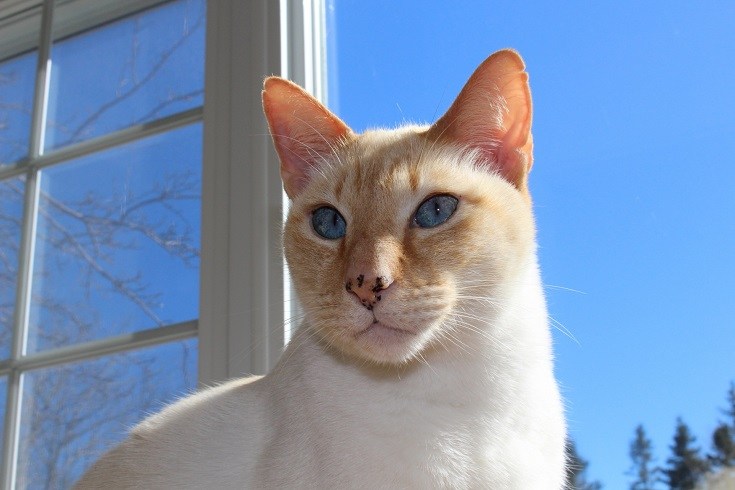
Also known as “flame point” and “orange point,” these Siamese cats have distinctive chestnut red points and pale pink noses and paw pads. To create this color, Siamese cats had to be crossed with tortoiseshells and red tabbies.
6. Cinnamon Point
Cinnamon point cats have a beautiful cinnamon shade across their points. Their faces may not be overly shaded, with the warm brown centered on their nasal area. The rest of their coat is warm ivory, and they will have pink to pale brown noses and pads.
7. Caramel Point
Siamese cats with caramel points will have warm gray-brown tones across their extremities. This can vary in darkness, but the color won’t normally extend across the whole of their heads and instead, will be concentrated on their nose and muzzle. Pads and noses are a soft gray with pink undertones.
8. Cream Point
Cream-pointed Siamese cats were created by crossing a red point Siamese with red Domestic Shorthair and Abyssinian cats. In comparison to the strong contrast of most Siamese points, the cream point has delicate cream points against a paler cream coat. Their nose leather and pads are a soft pink.
9. Fawn Point

Fawn-pointed Siamese cats have soft gray points and creamy-white bodies. The depth of color is not as strong as in the seal, chocolate, or blue-pointed Siamese cats. Fawn-pointed cats will have pink to gray nose leather and paw pads.
10. Apricot Point
Similar to the cream-pointed Siamese, the apricot point has subtle colored points in a soft orange shade, sometimes with pale tabby stripes extending farther onto their bodies. They may get freckled skin on their nose and lips. Their paw pads and noses are orangey-pink.
11. Foreign White
The foreign white is now sometimes accepted as a separate breed, but they are also frequently referred to as white Siamese cats. As the name suggests, these cats have pure white coats but, in all other respects, look exactly like a Siamese.
The foreign white was created by crossing Siamese cats with white British Shorthairs. This meant that a dominant white gene could be introduced. This masks the points that you would otherwise see on their coats.
Tabby Point Siamese Cats
12. Tabby Point
It’s thought that the stunning tabby point Siamese cats were first created in the 1940s by breeders in Scotland. They are sometimes also called shadow points or lynx point. Their points have a beautiful and distinct tabby stripe that will fade into their paler bodies. They will have the classic “M” tabby marking across their foreheads if their points are dark enough to show this.
Some breed associations don’t accept the tabby point as an official color because to achieve these markings, it was necessary to cross the Siamese with tabby-colored breeds at some point. Tabby points come in a wide range of colors, all of which are variations of the colors listed above but with tabby stripes.
13. Fawn Tabby Point
14. Blue Tabby Point
15. Seal Tabby Point

16. Lilac Tabby Point
17. Chocolate Tabby Point
18. Red Tabby Point
19. Cinnamon Tabby Point
20. Cream Tabby Point
21. Caramel Tabby Point
22. Apricot Tabby Point
Tortie Point Siamese Cats
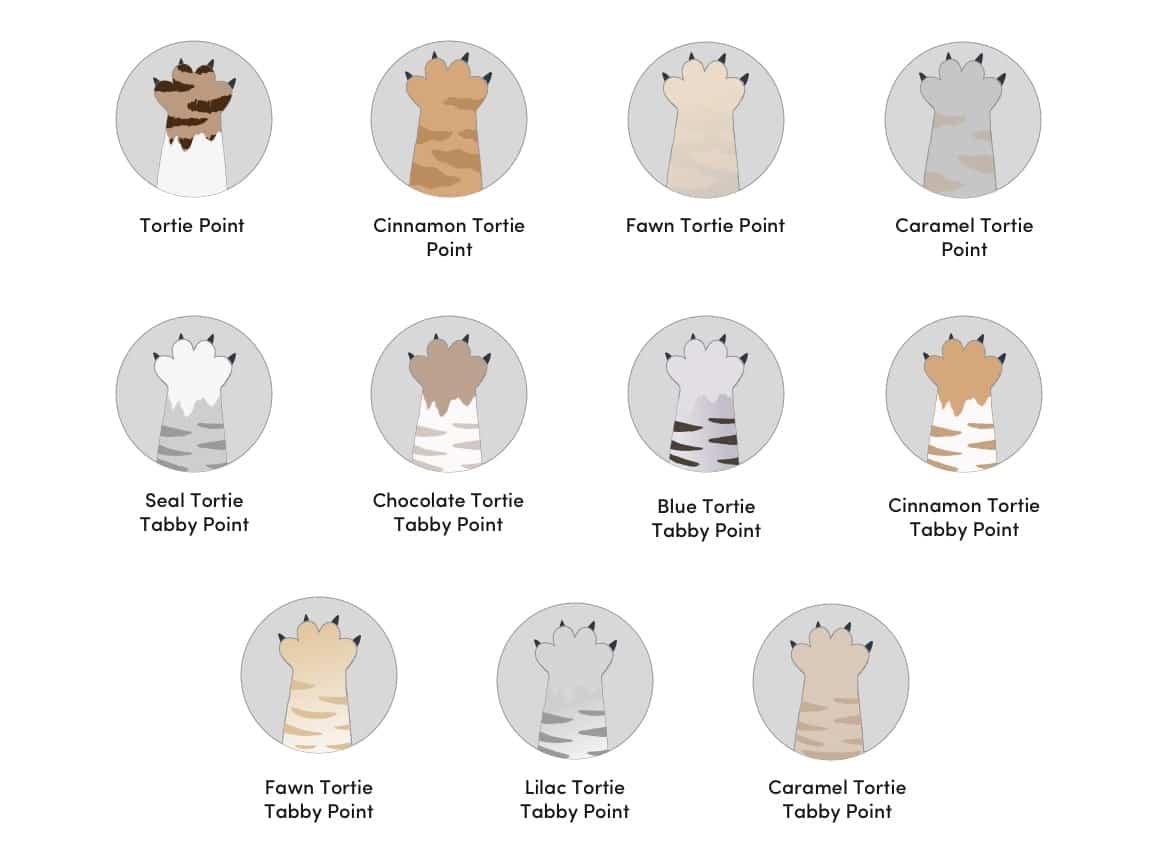
23. Tortie Point
As you might have guessed from the name, Tortie-point Siamese cats have points in stunning shades of tortoiseshell. They were created by crossing Siamese cats with a Tortoiseshell cat of a different breed. Tortie-point Siamese cats can be further split into the following.
24. Cinnamon Tortie Point
With classic tortoiseshell coloring in black and deep orange, the cinnamon Tortie-point cats will also have cream-colored fur across their bodies.
25. Fawn Tortie Point
A fawn Tortie-point cat will have markings across their points in a soft gray and pale orange. Their bodies are a pale cream fading into the points.
26. Caramel Tortie Point
A caramel Tortie-point cat has points made up of a blend of warm gray-brown tones and a soft apricot orange. Their bodies are a soft cream.
Tortie Tabby Point Siamese Cat Colors
If you have a Tortie with tabby markings, there are even more possibilities! These cats will have colored points that are a blend of tabby and tortie markings in many color combinations.
27. Seal Tortie Tabby Point
28. Chocolate Tortie Tabby Point
29. Blue Tortie Tabby Point
30. Cinnamon Tortie Tabby Point
31. Fawn Tortie Tabby Point
32. Lilac Tortie Tabby Point
33. Caramel Tortie Tabby Point
 Conclusion
Conclusion
Whatever your preference, there are plenty of beautiful shades out there to choose from, and some of them have stunning names to match.
Of course, you could decide to be surprised and choose a Siamese kitten while they’re still young enough to have the color of their points hidden by baby white coats. Imagine how exciting it will be to see their coats develop!
See Also:
- Ragdoll vs Siamese Cat: What’s the Difference? (With Pictures)
- Burmese vs. Siamese Cat: What’s the Difference? (With Pictures)
Featured Image Credit By: rihaij, Pixabay
Contents
- How Do Siamese Cats Get Their Color?
- Standard Siamese Cat Colors
- More Siamese Cat Colors
- 5. Red Point
- 6. Cinnamon Point
- 7. Caramel Point
- 8. Cream Point
- 9. Fawn Point
- 10. Apricot Point
- 11. Foreign White
- Tabby Point Siamese Cats
- 12. Tabby Point
- 13. Fawn Tabby Point
- 14. Blue Tabby Point
- 15. Seal Tabby Point
- 16. Lilac Tabby Point
- 17. Chocolate Tabby Point
- 18. Red Tabby Point
- 19. Cinnamon Tabby Point
- 20. Cream Tabby Point
- 21. Caramel Tabby Point
- 22. Apricot Tabby Point
- Tortie Point Siamese Cats
- Tortie Tabby Point Siamese Cat Colors
- 27. Seal Tortie Tabby Point
- 28. Chocolate Tortie Tabby Point
- 29. Blue Tortie Tabby Point
- 30. Cinnamon Tortie Tabby Point
- 31. Fawn Tortie Tabby Point
- 32. Lilac Tortie Tabby Point
- 33. Caramel Tortie Tabby Point
- Conclusion

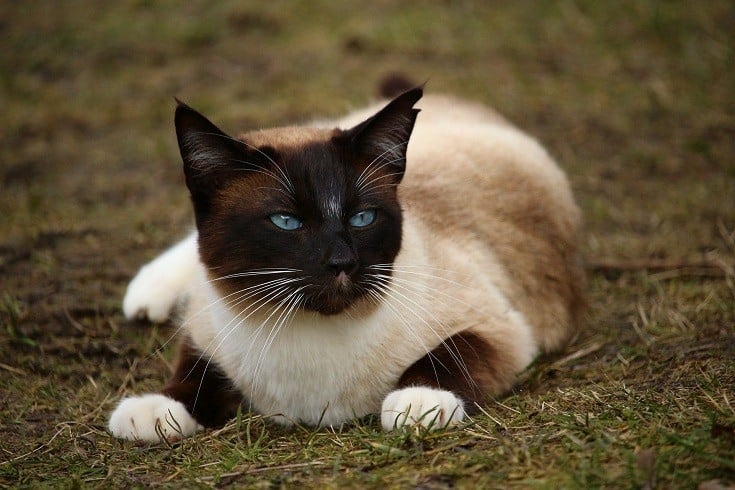






 Conclusion
Conclusion






